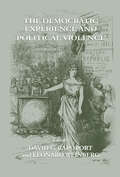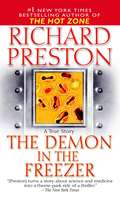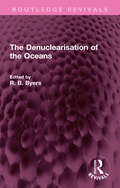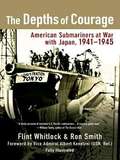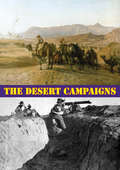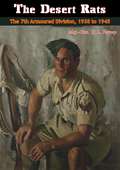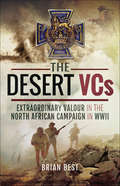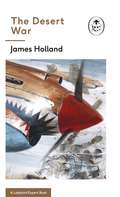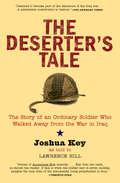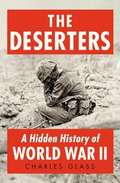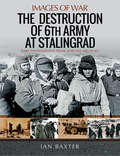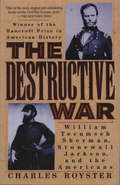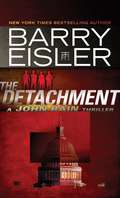- Table View
- List View
The Democratic Experience and Political Violence
by Leonard Weinberg David C. RapoportAn incisive analysis of the connections between democracy and violence by acknowledged experts in the field. The connection between the two activities has often been largely ignored because of a widespread reluctance among democrats to consider the possibility that democratic forms perhaps encourage violence. This challenging volume opens up the debate.
The Demon Crown: A Sigma Force Novel (Sigma Force #13)
by James Rollins“Bone-chilling.” –Publishers Weekly (Starred Review)“One of the best in the series.” –Booklist (Starred Review)To save mankind’s future, the members of Sigma Force must make a devil’s bargain as they join forces with their most hated enemy to stop an ancient threat in this gripping adventure from #1 New York Times bestselling author James Rollins.Off the coast of Brazil, a team of scientists discovers a horror like no other, an island where all life has been eradicated, consumed, and possessed by a species beyond imagination. Before they can report their discovery, a mysterious agency attacks the group, killing them all, save one: an entomologist, an expert on venomous creatures, Professor Ken Matsui from Cornell University.Strangest of all, this inexplicable threat traces back to a terrifying secret buried a century ago beneath the National Mall: a cache of bones preserved in amber. The artifact was hidden away by a cabal of scientists—led by Alexander Graham Bell—to protect humankind. But they dared not destroy it, for the object also holds an astonishing promise for the future: the very secret of life after death.Yet nothing stays buried forever. An ancient horror— dormant in the marrow of those preserved bones—is free once more, nursed and developed into a weapon of incalculable strength and malignancy, ready to wreak havoc on an unsuspecting world.To stop its spread, Commander Grayson Pierce of Sigma Force must survive a direct attack on the island of Maui. To be there first has always been the core mission of Sigma Force, a covert team forged to be America’s front line against emerging threats. But this time, even Sigma may not be able to decipher the deadly mystery, one that traces back to the founding of the Smithsonian Institution.With each new discovery, the menace they hunt is changing, growing, spreading—adapting and surviving every attempt to stop it from reconquering a world it once ruled. And each transformation makes it stronger . . . and smarter.Running out of time and options, Commander Grayson Pierce will be forced to make an impossible choice. To eradicate this extinction-level threat and expose those involved, he will have to join forces with Sigma’s greatest enemy—the newly resurrected Guild—even if it means sacrificing one of his own.
The Demon in the Freezer: A True Story
by Richard Preston<P>The first major bioterror event in the United States--the anthrax attacks in October 2001--was a clarion call for scientists who work with "hot" agents to find ways of protecting civilian populations against biological weapons. <P> In The Demon in the Freezer, his first nonfiction book since The Hot Zone, a #1 New York Times bestseller, Richard Preston takes us into the heart of Usamriid, the United States Army Medical Research Institute of Infectious Diseases at Fort Detrick, Maryland, once the headquarters of the U. S. biological weapons program and now the epicenter of national biodefense. <P>Peter Jahrling, the top scientist at Usamriid, a wry virologist who cut his teeth on Ebola, one of the world's most lethal emerging viruses, has ORCON security clearance that gives him access to top secret information on bioweapons. His most urgent priority is to develop a drug that will take on smallpox-and win. <P>Eradicated from the planet in 1979 in one of the great triumphs of modern science, the smallpox virus now resides, officially, in only two high-security freezers--at the Centers for Disease Control in Atlanta and in Siberia, at a Russian virology institute called Vector. <P>But the demon in the freezer has been set loose. It is almost certain that illegal stocks are in the possession of hostile states, including Iraq and North Korea. <P>Jahrling is haunted by the thought that biologists in secret labs are using genetic engineering to create a new superpox virus, a smallpox resistant to all vaccines. <P>Usamriid went into a state of Delta Alert on September 11 and activated its emergency response teams when the first anthrax letters were opened in New York and Washington, D.C. <P>Preston reports, in unprecedented detail, on the government's response to the attacks and takes us into the ongoing FBI investigation. <P>His story is based on interviews with top-level FBI agents and with Dr. Steven Hatfill. <P> Jahrling is leading a team of scientists doing controversial experiments with live smallpox virus at CDC. <P>Preston takes us into the lab where Jahrling is reawakening smallpox and explains, with cool and devastating precision, what may be at stake if his last bold experiment fails. <P><b>A New York Times Bestseller</b>
The Denuclearisation of the Oceans (Routledge Revivals)
by R. B. ByersIn the 1980s concern throughout the world was growing about the use of the oceans by nuclear-powered naval vessels and naval vessels carrying nuclear weapons. Many countries were keen to keep their ports and the waters off their coastlines "nuclear-free". Originally published in 1986, this book presents a worldwide survey of the state of the nuclear use of the oceans and assesses the prospects for denuclearisation at the time. It looks at the legal background, the practical issues and the attitudes and positions in different parts of the world. ‘… while regional efforts of disarmament and arms control are necessary, so are global efforts. At the same time, international legal norms, including the Law of the Sea, must be adopted and utilized in the ever difficult search for world peace’. Arvid Pardo.
The Department of Homeland Security: A Look Behind the Scenes (U.S. Government Behind the Scenes)
by Karen Latchana KenneyDescribes the history of the Department of Homeland Security, and how it has evolved, what the pressing issues are today, and what lies ahead in the near future. Takes a potentially dry topic and makes it accessible for the younger reader. Sidebars highlight important issues and figures in history.
The Deployment of Art: The Imperial War Museum’s Artistic Records Committee, 1968–1982 (Routledge Research in Art and Politics)
by Clare CarolinThis book explores the Artistic Records Committee (ARC) of the Imperial War Museum (IWM) as a bureaucratic mechanism that enabled the deployment of art as an instrument of war.The ARC was established in 1972 to commission artistic records of activities involving the British Armed Forces (BAF) deployed in the North of Ireland as part of Operation Banner. Through a close reading of artworks, archival research, and interviews with artists, former IWM staff, and a former British Army psychological operations (PSYOPs) expert, this book shows that the ARC was implicated in the ‘propaganda war’ that the British Government waged to counteract negative public perceptions of British military presence and activity in the North of Ireland after ‘Bloody Sunday,’ and later during Britain’s 1982 campaign to recapture the Falklands/Malvinas from Argentina (Operation Corporate). The two case studies are painter Ken Howard’s ARC commissions to record Operation Banner in 1973 and 1978 and illustrator Linda Kitson’s ARC commission to record the ‘Falklands Campaign’ in 1982. At a time when emergent conceptual and non-object-based art practices were increasingly concerned with exposure, concealment, and photographic evidence, the book demonstrates the potential operational significance of creating pictorial records and utilising art as a tool of warfare.This volume will be of interest to researchers and scholars of art history, museum studies, art and politics, and military and intelligence studies, as well as those studying the recent history of the North of Ireland and the Falklands/Malvinas war.
The Depths of Courage
by Flint Whitlock Ron SmithChosen by WWII History magazine as one of the Best Books of the Year.In the dark days after Pearl Harbor, the small, illequipped arm of the Navy known as Submarine Force would stand between the shattered U.S. Pacific Fleet and the might of the Japanese Navy. Unfortunately, the spirit and courage of the Submarine Force is being forgotten as the veterans of that force pass into history. To preserve their heroic tales of war beneath the sea, critically acclaimed author and military historian Flint Whitlock, in collaboration with decorated World War II submarine veteran Ron Smith, set out on a journey of more than two years to interview submariners and to record their accounts before the memories of their endeavors are lost forever. These are their stories.
The Desegregated Heart: A Virginian’s Stand in Time of Transition
by Sarah Patton BoyleSarah Patton Boyle's personal crusade for civil rights began in the fall of 1950, when the University of Virginia refused to admit Gregory Swanson, the Negro student who challenged its policy of segregation. Confident that this wrong could be righted quickly, Mrs. Boyle, the wife of a professor at the University, went forth to do her share--to meet not only with the burning crosses of white hatred but with decided wariness on the part of Negroes.Here is the story of Mrs. Boyle's lonely struggle--the more courageous for her aristocratic Virginia background and traditional Southern upbringing. It is also the story of her painful re-education--of a Southerner's discovery of "the real Negro, the real white man, and herself."A fascinating, reaffirming read."It should be read by everyone with the brotherhood of man."--Dr. Martin Luther King, Jr."A most interesting and revealing book, honest, compassionate. The South needs it; Negroes need it; northerners need it. It is beautiful in its candor and deeply moving...."--Lillian Smith
The Desert Air Force in World War II: Air Power in the Western Desert, 1940-1942
by Ken DelveThis is a comprehensive reference to the structure, operation, aircraft and men of the 1st Tactical Air Force, or Desert Air Force as it became known. It was formed in North Africa to support the 8th Army and included squadrons from the RAF, SAAF, RAAF and eventually the USAAF. The book includes descriptions of many notable defensive and offensive campaigns, the many types of aircraft used, weapons and the airfields that played host to these events. The five main sections of the book include a general historical introduction and overview, operations, operational groups, aircrew training and technical details of each aircraft type. Lengthy annexes cover personnel, the squadrons in World War II, accuracy of attacks, orders of battle for each wartime year, maps of airfield locations and numbers of enemy aircraft downed.
The Desert Campaigns [Illustrated Edition]
by William Thomas MasseyIncludes more than 20 illustrations by James McBey and the World War One In The Desert Illustration Pack- 115 photos/illustrations and 19 maps spanning the Desert campaigns 1914-1918"Written by the foremost accredited London newspaper journalist in the Middle East during the Great War, William Massey covered the war in the Middle East as it was fought against the Ottoman Turkish Empire, its German ally and the tribes of the region who supported them. He was aware of the hardships suffered by the British and Colonial troops serving in the difficult climate and later became a champion of those who fought there. He writes of the complete conflict from the battles in the western desert with the Senussi to Aleppo and beyond to the borders of Turkey."-Print Edition"Mr. Massey, who was the official correspondent with our forces, was moved to write this highly interesting account of the campaigns in Egypt on being told by a colleague on the Western Front that the Army in Egypt should " come to. France to see what war is." He shows that the British, Australian, New Zealand, and South African troops in Eastern and Western Egypt had a very arduous experience of war, and that the battle of Romani in August, 1916, was a hard-fought and decisive victory, in which the Turks lost nearly half their strength. At first we were content to hold the line of the Canal, Leaving the Desert to the Turks. But this defensive policy involved grave risks. Mr. Massey reminds us that the Turks repeatedly tried to lay mines in the Canal, and once succeeded in damaging a ship, so that traffic was delayed for half-a-day. The true policy, afterwards adopted, of holding a line far to the east of the Canal, and then of clearing the Turks out of Sinai altogether, meant very hard work for the Army and the Labour Corps, but was completely successful. Mr. Massey describes at the close the remarkable little operations against the Senussi in Western Egypt."-review in The Spectator 24th May 1918
The Desert Nurse: A grand love story set in a far-flung theatre of war
by Pamela HartAmid the Australian Army hospitals of World War I Egypt, two deeply determined individuals find the resilience of their love tested to its limitsIt's 1911, and 21-year-old Evelyn Northey desperately wants to become a doctor. Her father forbids it, withholding the inheritance that would allow her to attend university. At the outbreak of World War I, Evelyn disobeys her father, enlisting as an army nurse bound for Egypt and the disastrous Gallipoli campaign. Under the blazing desert sun, Evelyn develops feelings for polio survivor Dr William Brent, who believes his disability makes him unfit to marry. For Evelyn, still pursuing her goal of studying medicine, a man has no place in her future. For two such self-reliant people, relying on someone else for happiness may be the hardest challenge of all.From the casualty tents, the fever wards and the operating theatres of the palace; through the streets of Cairo during Ramadan, to the parched desert and the grim realities of war, Pamela Hart, beloved bestselling Australian author of THE WAR BRIDE, tells the heart-wrenching story of four years that changed the world forever.
The Desert Nurse: A grand love story set in a far-flung theatre of war
by Pamela HartAmid the Australian Army hospitals of World War I Egypt, two deeply determined individuals find the resilience of their love tested to its limits It's 1911, and 21-year-old Evelyn Northey desperately wants to become a doctor. Her father forbids it, withholding the inheritance that would allow her to attend university. At the outbreak of World War I, Evelyn disobeys her father, enlisting as an army nurse bound for Egypt and the disastrous Gallipoli campaign. Under the blazing desert sun, Evelyn develops feelings for polio survivor Dr William Brent, who believes his disability makes him unfit to marry. For Evelyn, still pursuing her goal of studying medicine, a man has no place in her future. For two such self-reliant people, relying on someone else for happiness may be the hardest challenge of all. From the casualty tents, fever wards and operating theatres; through the streets of Cairo during Ramadan; to the parched desert and the grim realities of war, Pamela Hart, author of THE WAR BRIDE, tells the heart-wrenching story of four years that changed the world forever.
The Desert Rats: The 7th Armoured Division in World War II
by G. L. VerneyThe exploits of the Desert Rats Based on official records and personal accounts Traces the division's progress in North Africa, Italy, Normandy and Germany This classic and inspiring account of the progress of the 7th Armoured Division from the sands of North Africa to the cold of wintery Holland and the mud of a German springtime. Based on official records, and written by one of the division's key officers, this book is an outstanding testament to the officers and men of an astonishing unit. The division's reputation was born in the desert. It first went into action against the Italians in 1940 and then, subsequently, fought Rommel's Afrika Korps in Montgomery's successful Western Desert campaign. It was during this period of intense fighting that the division won its affectionate nickname of 'Desert Rats'. From there the division was transported to Italy and, later, Normandy and from then on was almost constantly in battle until the end of the war. The Desert Rats was written with official support, and with the help of most of the division's senior officers, and the author has been able to provide a unique insight into the workings of a formidable unit. The book stands testament to the unique morale of the division and is an enduring story of difficulties overcome. Major-General Verney served as a tank brigade commander in World War II and went on to command 7th Armoured Division in Normandy in 1944.
The Desert Rats: The 7th Armoured Division, 1938 to 1945
by Maj.-Gen. G. L. VerneyThe exploits of the Desert Rats, based on official records and personal accounts traces the division’s progress in North Africa, Italy, Normandy and GermanyThis classic and inspiring account follows the progress of the 7th Armoured Division from the sands of North Africa to the cold of wintery Holland and the mud of a German springtime, providing a unique insight into the workings of a formidable unit.The division’s reputation was born in the desert. It first went into action against the Italians in 1940 and then, subsequently, fought Rommel’s Afrika Korps in Montgomery’s successful Western Desert campaign.It was during this period of intense fighting that the division won its affectionate nickname of ‘Desert Rats’.From there the division was transported to Italy and, later, Normandy and from then on was almost constantly in battle until the end of the war.Based on official records, and written by one of the division’s key officers, The Desert Rats stands testament to the unique morale of the unit and is an enduring story of the difficulties they had to overcome.
The Desert VCs: Extraordinary Valour in the North African Campaign in WWII
by Brian BestIt was not just the searing heat of the day, hot enough to boil an egg on the bonnet of a lorry, or the sand that nestled in every crevice of the body, or the shivering cold of the starlit nights, that the British and Commonwealth troops had to battle in the North African desert it was also the tough and determined Axis forces under their brilliant leader, Erwin Rommel.The actions which resulted in the awarding of twenty-nine VCs in the Desert War included that of stretcher bearer Private Anderson walking alone into the gunfire of the enemy to rescue wounded comrades, not once, but time and time again until he too was shot and killed. Lieutenant George Gunn, who, at Sidi Rezegh, found his troop of the Royal Horse Artillery facing the onslaught of sixty German tanks. One by one the guns were put out of action, the crews killed or wounded. Eventually, only one gun was left, manned by the twenty-nine-year-old lieutenant and his sergeant. Regardless of the odds, Gunn fought on until he too was killed, shot through the head.The fighting in North Africa was not just in the harsh extremes of the rolling desert, but also the barren mountains of Tunisia, and the coastal strips of Libya. In every battle, every maneuver, the terrain was the limiting or enabling feature and it was over that unforgiving ground that twenty-nine men distinguished themselves and were awarded the highest of all gallantry medals, the Victoria Cross.
The Desert War: Book 4 of the Ladybird Expert History of the Second World War (The Ladybird Expert Series #10)
by James HollandPart of the ALL-NEW LADYBIRD EXPERT SERIES.____________Why was North Africa such a key component in Britain's success over Mussolini and his Italian Army?How did they blunt Italy's actions?What challenges did they face?And what new technologies were brought to bear?When fascist dictator Mussolini declared war against Britain he was taking a huge risk . . . Italy lacked natural resources, and Britain and France's wealth.He hoped to create a new Roman Empire across the Mediterranean and into Africa. And with Hitler and the Nazi's by his side he had a great chance of doing so - but what was it that stopped him?Discover the answers and more inside James Holland's The Desert War, the thrilling and accessible account that explains what happened, who the key figures were and the tactics, triumphs and failures on both sides . . .
The Deserter
by Nelson DeMille Alex DeMilleMilitary cop Scott Brodie is the guy you send in when the other guys can't solve a case. Now he's on the hunt for a dangerous ex-Delta Force deserter named Kyle Mercer, and may have met his match.***The brand new novel from America's Greatest Living Thriller Writer.***When Delta Force Captain Kyle Mercer disappeared from his post in Afghanistan, a video released by his Taliban captors made international headlines. But circumstances were murky: Did Mercer desert before he was captured? Then a second video sent to Mercer's Army commanders leaves no doubt: the trained assassin and keeper of classified Army intelligence has willfully disappeared.When Mercer is spotted a year later in Caracas, Venezuela, top military brass task Scott Brodie and Maggie Taylor of the Criminal Investigation Division to fly to Venezuela and bring Mercer back to America-dead or alive. Brodie knows this is a difficult mission, made more difficult by his new partner's inexperience and by his suspicion that Maggie Taylor is reporting to the CIA.Tense, exotic and inspired by a real-life story, the new thriller from number one New York Times bestseller Nelson DeMille and his son, screenwriter Alex DeMille is an absolute must read.
The Deserter (Scott Brodie)
by Nelson DeMille Alex DeMille***The first in a new series from America's Greatest Living Thriller Writer.***Military cop Scott Brodie is the guy you send in when the other guys can't solve a case. Now he's on the hunt for a dangerous ex-Delta Force deserter named Kyle Mercer, and may have met his match.When Delta Force Captain Kyle Mercer disappeared from his post in Afghanistan, a video released by his Taliban captors made international headlines. But circumstances were murky: Did Mercer desert before he was captured? Then a second video sent to Mercer's Army commanders leaves no doubt: the trained assassin and keeper of classified Army intelligence has willfully disappeared.When Mercer is spotted a year later in Caracas, Venezuela, top military brass task Scott Brodie and Maggie Taylor of the Criminal Investigation Division to fly to Venezuela and bring Mercer back to America-dead or alive. Brodie knows this is a difficult mission, made more difficult by his new partner's inexperience and by his suspicion that Maggie Taylor is reporting to the CIA.Tense, exotic and inspired by a real-life story, the new thriller from number one New York Times bestseller Nelson DeMille and his son, screenwriter Alex DeMille is an absolute must read.
The Deserter (Voyageur Classics #31)
by Michael Gnarowski Douglas LePan Scott RayterA new edition of the classic novel by Douglas LePan. Returned from the ravages of war, met with a city that offers him only despair, a young man finds himself caught between two opposing worlds — the ordered but empty everyday life of “schedules and obligations,” and the hellish chaos of the city’s underside, a dark world of brutality and vice. Gripped with a restless passion for perfection, haunted by a brief and idealized experience of love, the hero of this poetic, experimental novel lives out in a modern context that most universal of myths: the descent into the underworld to experience initiations and ordeals, and the return with new understanding to the upper world.
The Deserter's Tale: The Story of an Ordinary Soldier Who Walked Away from the War in Iraq (Books That Changed the World)
by Lawrence Hill Joshua Key&“Apocalypse Now insanity . . . if this is what one soldier saw in seven months, imagine the sum total of the inhumanity being perpetuated in Iraq&” (Toronto Star). The first memoir from a soldier who deserted from the war in Iraq, and a vivid and damning indictment of the American military campaign, The Deserter&’s Tale is &“destined to become part of the literature of the Iraq war . . . a substantial contribution to history&” (Los Angeles Times). In Spring 2003, young Oklahoman Joshua Key was sent to Ramadi as part of a combat engineer company. It was not the campaign against terrorists and evildoers he had expected. Key saw Iraqi civilians beaten, shot, and killed, or maimed for little or no provocation. After seven months in Iraq, Key was home on leave and knew he could not return. So he took his family and went underground in the United States, finally seeking asylum in Canada after fourteen months in hiding. Detailing the grinding horrors of life as part of an occupying force, The Deserter&’s Tale is the story of a conservative-minded family man and patriot who went to war believing unquestioningly in his government&’s commitment to integrity and justice, and how what he saw in Iraq transformed him into someone who could no longer serve his country. &“Devastating . . . The questions [Key] raises . . . will not go away.&” —Daily Kos &“A tearjerker . . . Lawrence Hill, the award-winning Canadian novelist and journalist who helped Key write The Deserter&’s Tale, does a marvelous job preserving Key&’s authentic voice. The writing is fluid, crisp and compelling. The story is shocking.&” —Montreal Gazette
The Deserters: A Hidden History of World War II
by Charles Glass"Powerful and often startling...The Deserters offers a provokingly fresh angle on this most studied of conflicts." --The Boston Globe A groundbreaking history of ordinary soldiers struggling on the front lines, The Deserters offers a completely new perspective on the Second World War. Charles Glass--renowned journalist and author of the critically acclaimed Americans in Paris: Life and Death Under Nazi Occupation--delves deep into army archives, personal diaries, court-martial records, and self-published memoirs to produce this dramatic and heartbreaking portrait of men overlooked by their commanders and ignored by history. Surveying the 150,000 American and British soldiers known to have deserted in the European Theater, The Deserters: A Hidden History of World War II tells the life stories of three soldiers who abandoned their posts in France, Italy, and Africa. Their deeds form the backbone of Glass's arresting portrait of soldiers pushed to the breaking point, a sweeping reexamination of the conditions for ordinary soldiers. With the grace and pace of a novel, The Deserters moves beyond the false extremes of courage and cowardice to reveal the true experience of the frontline soldier. Glass shares the story of men like Private Alfred Whitehead, a Tennessee farm boy who earned Silver and Bronze Stars for bravery in Normandy--yet became a gangster in liberated Paris, robbing Allied supply depots along with ordinary citizens. Here also is the story of British men like Private John Bain, who deserted three times but never fled from combat--and who endured battles in North Africa and northern France before German machine guns cut his legs from under him. The heart of The Deserters resides with men like Private Steve Weiss, an idealistic teenage volunteer from Brooklyn who forced his father--a disillusioned First World War veteran--to sign his enlistment papers because he was not yet eighteen. On the Anzio beachhead and in the Ardennes forest, as an infantryman with the 36th Division and as an accidental partisan in the French Resistance, Weiss lost his illusions about the nobility of conflict and the infallibility of American commanders. Far from the bright picture found in propaganda and nostalgia, the Second World War was a grim and brutal affair, a long and lonely effort that has never been fully reported--to the detriment of those who served and the danger of those nurtured on false tales today. Revealing the true costs of conflict on those forced to fight, The Deserters is an elegant and unforgettable story of ordinary men desperately struggling in extraordinary times.
The Destruction of 6th Army at Stalingrad (Images of War)
by Ian BaxterA pictorial history of the last months of Nazi Germany’s 6th Army at the Battle of Stalingrad during World War II.The scale of death and destruction during the Battle of Stalingrad during late 1942 and early 1943 remains unprecedented in the history of warfare.The annihilation of General von Paulus’s 6th Army epitomized the devastating defeat of Hitler’s ambition to conquer Stalin’s Soviet Union. After the successful Operation Blue offensive, the 6th Army reached the River Volga north of Stalingrad in summer 1942. With overextended supply lines and facing steely opposition, increasingly desperate attempts to seize the city repeatedly failed. Slowly 6th Army became encircled. The German High Command attempted several relief attempts, notably Field Marshal von Manstein’s “Winter Storm,” but all were defeated by the tenacity of the enemy and the Russian winter. To their credit, the men of the 6th Army fought to the end, but by February 1943, the last pockets of German resistance were either destroyed or had surrendered.Thanks to a superb collection of unpublished photographs, this entry in the Images of War series provides an absorbing insight into the dramatic events of the last months of the 6th Army’s doomed existence.
The Destruction of 6th Army at Stalingrad (Images of War)
by Ian BaxterThe scale of death and destruction during the Battle of Stalingrad during late 1942 and early 1943 remains unprecedented in the history of warfare. The annihilation of General von Paulus’ 6th Army epitomized the devastating defeat of Hitler’s ambition to conquer Stalin’s Soviet Union. After the successful Operation Blue offensive 6th Army reached the River Volga north of Stalingrad in summer 1942. With overextended supply lines and facing steely opposition, increasingly desperate attempts to seize the city repeatedly failed. Slowly 6th Army became encircled. The German High Command attempted a number of relief attempts, notably Field Marshal von Manstein’s ‘Winter Storm’ but all were defeated by the tenacity of the enemy and the Russian winter. To their credit the men of 6th Army fought to the end but by February 1943 the last pockets of German resistance were either destroyed or had surrendered. Thanks to a superb collection of unpublished photographs, this Images of War book provides an absorbing insight into the dramatic events of the last months of 6th Army’s doomed existence.
The Destructive War: William Tecumseh Sherman, Stonewall Jackson, and the Americans
by Charles RoysterFrom the moment the Civil War began, partisans on both sides were calling not just for victory but for extermination. And both sides found leaders who would oblige. In this vivid and fearfully persuasive book, Charles Royster looks at William Tecumseh Sherman and Stonewall Jackson, the men who came to embody the apocalyptic passions of North and South, and re-creates their characters, their strategies, and the feelings they inspired in their countrymen. At once an incisive dual biography, hypnotically engrossing military history, and a cautionary examination of the American penchant for patriotic bloodshed, The Destructive War is a work of enormous power.From the Trade Paperback edition.
The Detachment (John Rain Thriller #7)
by Barry EislerWhen legendary black ops veteran Colonel Scott "Hort" Horton tracks Rain down in Tokyo, Rain can't resist the offer: a multi-million dollar payday for the "natural causes" demise of three ultra-high-profile targets who are dangerously close to launching a coup in America. But the opposition on this job is going to be too much for even Rain to pull it off alone. He'll need a detachment of other deniable irregulars: his partner, the former Marine sniper, Dox. Ben Treven, a covert operator with ambivalent motives and conflicted loyalties. And Larison, a man with a hair trigger and a secret he'll kill to protect. From the shadowy backstreets of Tokyo and Vienna, to the deceptive glitz and glamour of Los Angeles and Las Vegas, and finally to a Washington, D. C. in a permanent state of war, these four lone wolf killers will have to survive presidential hit teams, secret CIA prisons, and a national security state as obsessed with guarding its own secrets as it is with invading the privacy of the populace. But first, they'll have to survive each other. The Detachment is what fans of Eisler, "one of the most talented and literary writers in the thriller genre" (Chicago Sun-Times), have been waiting for: the worlds of the award-winning Rain series, and of the bestselling Fault Line and Inside Out, colliding in one explosive thriller as real as today's headlines and as frightening as tomorrow's.
